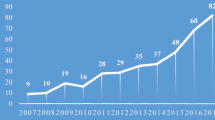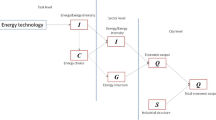Abstract
Cities are the main material processors associated with industrialization. The development of urban production based on fossil fuels is the major contributor to the rise of greenhouse gas density, and to global warming. The concept of urban industrial structure optimization is considered to be a solution to urban sustainable development and global climate issues. Enforcing energy conservation and reducing carbon emissions are playing key roles in addressing these issues. As such, quantitative accounting and the evaluation of energy consumption and corresponding carbon emissions, which are by-products of urban production, are critical, in order to discover potential opportunities to save energy and to reduce emissions. Conventional evaluation indicators, such as “energy consumption per unit output value” and “emissions per unit output value”, are concerned with immediate consumptions and emissions; while the indirect consumptions and emissions that occur throughout the supply chain are ignored. This does not support the optimization of the overall urban industrial system. To present a systematic evaluation framework for cities, this study constructs new evaluation indicators, based on the concepts of “embodied energy” and “embodied carbon emissions”, which take both the immediate and indirect effects of energy consumption and emissions into account. Taking Beijing as a case, conventional evaluation indicators are compared with the newly constructed ones. Results show that the energy consumption and emissions of urban industries are represented better by the new indicators than by conventional indicators, and provide useful information for urban industrial structure optimization.
Similar content being viewed by others
References
Ahmad N, Wyckoff A W (2003). Carbon Dioxide Emissions Embodied in International Trade of Goods. Organization for Economic Cooperation and Development (OECD), Paris, France
Cao S, Wang X, Wang G (2009). Lessons learned from China’s fall into the poverty trap. J Policy Model, 31(2): 298–307
CEPY (2006). China Electricity Power Yearbook 2006. Beijing: China Electricity Power Press (in Chinese)
Chen G Q, Chen Z M (2010). Carbon emissions and resources use by Chinese economy 2007: a 135-sector inventory and input-output embodiment. Commun Nonlinear Sci Numer Simul, 15(11): 3647–3732
Chen H, Chen G Q, Ji X (2010a). Cosmic emergy based ecological systems modelling. Commun Nonlinear Sci Numer Simul, 15(9): 2672–2700
Chen L, Cao S (2013). Lack of integrated solutions hinders environmental recovery in China. Ecol Eng, 54: 233–235
Chen ZM(2014). Inflationary effect of coal price change on the Chinese economy. Appl Energy, 114: 301–309 http://dx.doi.org/10.1016/j.apenergy.2013.09.068
Chen Z M, Chen G Q (2011a). An overview of energy consumption of the globalized world economy. Energy Policy, 39(10): 5920–5928
Chen Z M, Chen G Q (2011b). Embodied carbon dioxide emission at supra-national scale: a coalition analysis for G7, BRIC, and the rest of the world. Energy Policy, 39(5): 2899–2909
Chen Z M, Chen G Q (2013). Demand-driven energy requirement of world economy 2007: a multi-region input-output network simulation. Commun Nonlinear Sci Numer Simul, 18(7): 1757–1774
Chen ZM, Chen G Q, Zhou J B, Jiang MM, Chen B (2010b). Ecological input-output modeling for embodied resources and emissions in Chinese economy 2005. Commun Nonlinear Sci Numer Simul, 15(7): 1942–1965
Costanza R (1980). Embodied energy and economic valuation. Science, 210(4475): 1219–1224
Costanza R, Herendeen R A (1984). Embodied energy and economic value in the United States economy: 1963, 1967 and 1972. Resour Energy, 6(2): 129–163
Davis S J, Caldeira K (2010). Consumption-based accounting of CO2 emissions. Proc Natl Acad Sci USA, 107(12): 5687–5692
Dhakal S (2009). Urban energy use and carbon emissions from cities in China and policy implications. Energy Policy, 37(11): 4208–4219
Fridley D, Zheng N, Zhou N (2012). Urban RAM: assessing the energy impact of having people in cities. Preprint version of paper for conference proceedings, ACEEE Summer Study on Energy Efficiency in Buildings, Pacific Grove, California.
Gong C, Xu C, Chen L, Cao S (2012). Cost-effective compensation payments: a model based on buying green cover to sustain ecological restoration. For Policy Econ, 14(1): 143–147
Guan L, Sun G, Cao S (2011). China’s bureaucracy hinders environmental recovery. Ambio, 40(1): 96–99
IPCC (2006). Guidelines for National Greenhouse Gas Inventories. IGES, Japan, 2006
Ji X (2011). Ecological accounting and evaluation of urban economy: taking Beijing city as the case. Commun Nonlinear Sci Numer Simul, 16(3): 1650–1669
Ji X, Chen G Q (2010). Unified account of gas pollutants and greenhouse gas emissions: Chinese transportation 1978–2004. Commun Nonlinear Sci Numer Simul, 15(9): 2710–2722
Judson D H (1989). The convergence of neo-Ricardian and embodied energy theories of value and price. Ecol Econ, 1(3): 261–281
Leontief W (1970). Environmental repercussions and the economic structure: an input-output approach. Rev Econ Stat, 52(3): 262–271
Liu H, Polenske K R, Guilhoto J J M, Xi Y (2011). Direct and indirect energy consumption in China and the United States. MPRA Paper 37960, University Library of Munich, Germany.
NBSC (2006). China Statistical Yearbook 2006. Beijing: China Statistical Publishing House (in Chinese)
Nishimura K, Hondo H, Uchiyama Y (1997). Estimating the embodied carbon emissions from the material content. Energy Convers Manage, 38: S589–S594
Peters G P, Hertwich E G (2008). CO2 embodied in international trade with implications for global climate policy. Environ Sci Technol, 42(5): 1401–1407
Stern N (2007). The Economics of Climate Change: The Stern Review. Cambridge: Cambridge University Press
Weber C L, Matthews H S (2008). Quantifying the global and distributional aspects of American household carbon footprint. Ecol Econ, 66(2–3): 379–391
Wu L Y, Wu W J (2008). Research and Suggestions on the Urbanization with Chinese Characteristics. Beijing: Commercial Press (in Chinese)
Wyckoff A W, Roop J M (1994). The embodiment of carbon in imports of manufactured products: implications for international agreements on greenhouse gas emissions. Energy Policy, 22(3): 187–194
Yuan X H, Ji X, Chen H, Chen B, Chen G Q (2008). Urban dynamics and multiple-objective programming: a case study of Beijing. Commun Nonlinear Sci Numer Simul, 13(9): 1998–2017
Zheng H, Cao S (2011). The challenge to sustainable development in China revealed by “death villages”. Environ Sci Technol, 45(23): 9833–9834
Zhou J B (2008). Embodied ecological elements accounting of national economy. Dissertation for Ph.D Degree, Peking University, 2008 (in Chinese)
Author information
Authors and Affiliations
Corresponding authors
Rights and permissions
About this article
Cite this article
Ji, X., Chen, Z. & Li, J. Embodied energy consumption and carbon emissions evaluation for urban industrial structure optimization. Front. Earth Sci. 8, 32–43 (2014). https://doi.org/10.1007/s11707-013-0386-7
Received:
Accepted:
Published:
Issue Date:
DOI: https://doi.org/10.1007/s11707-013-0386-7




